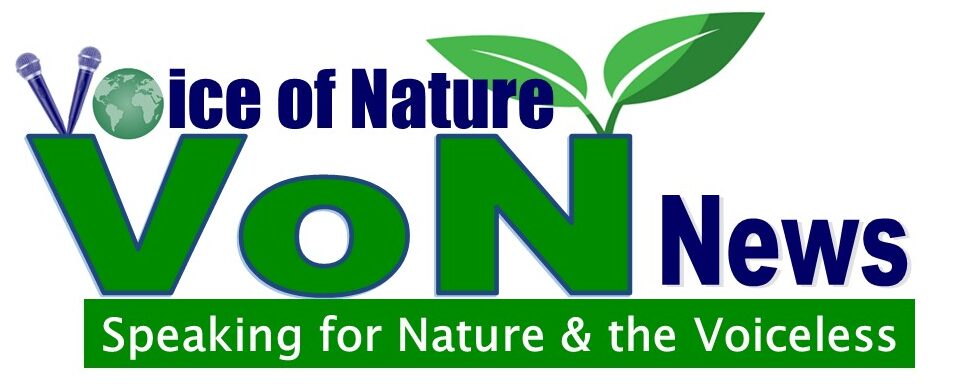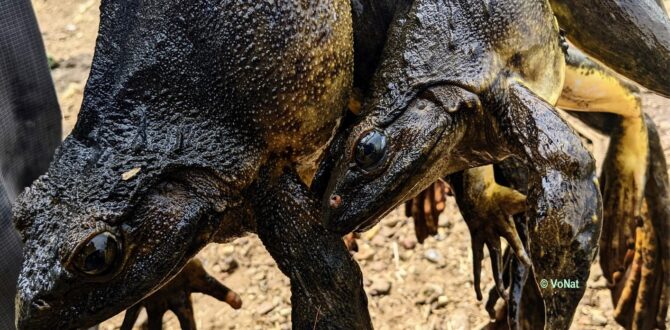By Ndimuh B. Shancho
_________________
The goliath frog (Conraua goliath), which is the world’s largest frog, is a giant slippery frog located in the Mount Nlonako Area, Littoral Region of Cameroon, and the Equatorial Guinea. Just like the name goliath, the frog is indeed big! A fully grown goliath frog weighs up to 3.3kg and is up to 30cm long. The frog lives in secondary forests and near flowing streams and waterfalls from where they come out at night to feed on insects, fish, and other smaller amphibians. Through its feeding habit, the giant slippery frog contributes to limiting the spread of malaria and yellow fever, which are deadly diseases in Cameroon and other parts of Africa.
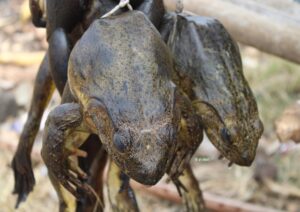
On the basis of statistics from researchers, at least 20000 of this emblematic species in Cameroon are harvested and sold every peak season that is from November to February. This means that up to 5000 individuals of this emblematic species in Cameroon disappear from the earth surface every month during its peak season.
Kola is a community in the Littoral Region of Cameroon known for the buying and selling of the goliath frog. On this Friday morning, at about 8 am, Emmanuel Njong, born in Kola some 35 years ago and his friend, who declines to give his name to “strangers”, are at the road site with piles of frogs hunted the previous night, for sale. Emmanuel’s friend has a pile of five giant frogs on his left hand and another pile of five on his right hand. He lifts them up and runs with them towards any car that slows down hoping to have a sale, while Emmanuel seats in a make shift thatched hurt, probably resting after a night of goliath frog hunting.
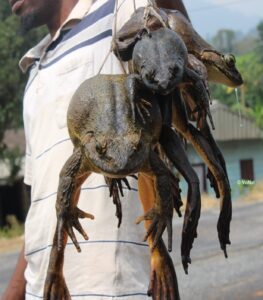
As my colleague, Sandrine Akeabeh, and I move towards the hurt to engage Emmanuel in a chat, we stumble on a bucket with water and large frogs. Without waiting for us to ask, Emmanuel indicates: “we put them in the water so they can stay alive”. According to him, live frogs are more expensive than dead ones. “We sell a pile of four live frogs for up to XAF 20000 (circa $ 40) or even XAF 50000 ($100) for those with big cars while a pile of four dead ones for just XAF 10000 (about $ 20),” he adds. Emmanuel hints that unsold frogs are dried for home consumption. He discloses that the frogs are good for pregnant women. “When my wife is pregnant, I prepare some of the biggest sizes of the frogs for her to eat. It makes the child healthy and strong when put to bed. If you see my last son; he is very strong and healthy because of this,” he asserts. In the course of our discussion, I saw a large bag shaking. He noticed the shock in my eyes and immediately clarifies: “those more frogs. I also collect from other hunters and sell for us to share proceeds”. For the close to 1 hour of our chat, about 4 piles of the giant slippery frogs that is about 20 frogs were sold.
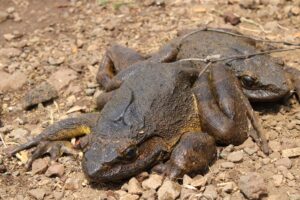
The Kola denizen who is into hunting the goliath frogs for the past 15 years, hunts twice a week. “We hunt every Thursday and Friday. We usually set out for hunting at night, about 8pm. When we see the frog, we point the torch straight into its eyes to make it confused, move closer and then threw the net to catch it,” he recounts. The goliath frog hunter, attests he has been eating the frogs since he was conceived in his mothers womb. He does not believe the frogs can become extinct. The goliath frog is classified as Endangered on the IUCN Red List. With the rate at which the giant slippery frog is being harvested, conservationists and researchers are unanimous that it may disappear from the earth surface in the near future if no urgent conservation actions are taken.
VoNat Weighs in!
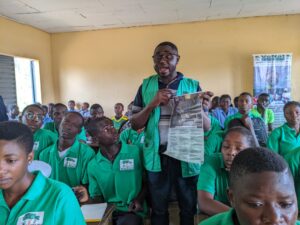
A Cameroon-based biodiversity conservation and sustainable development non-profit organization, Voice of Nature (VoNat), which I founded in 2019, has since launched a programme to save the goliath frog from extinction. In July 2022, I received a grant from the National Geographic Society, which the Organization has leveraged to educate 100 kids and young adults from five communities within the Mount Nlonako Area on the ecology, behaviour, distribution of amphibians around the world, conservation threats/importance, and the actions they can take. “We belief that educating and engaging the children in fighting against the wanton depletion of the goliath frog will ensure sustainability. This is because they are the leaders of tomorrow and will be the ones to take decisions and enact laws regarding the conservation of the species. Also, they will be able to take the conservation message to their parents, who will belief more in them than strangers,” Mr. Nkede Henry Nkede, VoNat’s Amphibians Conservation Programme Field Coordinator said shortly after a conservation education session about the frogs.
Ecological Study
Apart from the education sessions, the youngsters are engaged in ecological studies of amphibians and other species in their range habitats using mobile apps, both during the day and in the night. Over 62 observations are made with up to 22 species identified including amphibians species, fish, reptiles and insects, during these sessions. These observations include but not limited to direct observation of species in their habitats (dead and alive), feeding signs, dungs, threats, vocalization and others.
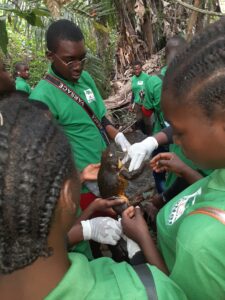
“I can see feces of the goliath frog, something I have never seen before. I can also see a snake, though it is not alive,” Ebude Christabel from Ntolo community says during the study. Marie Therese from Nkongnine and her friends are particularly thrilled seeing the goliath frog in its natural habitat for the first time. “This is my first time seeing the Goliath frog and other species in their natural habitat. I am so happy because not everyone is given this kind of opportunity,” Marie Therese said.
Kids take Action
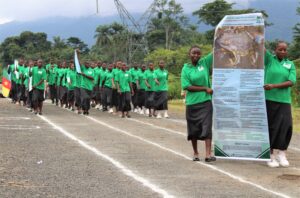
The education and ecological study sessions organized by VoNat ignite fresh love for goliath frogs and other endangered amphibians in the kids and youths of the Mount Nlonako Area. With the lessons learnt and new found love in goliath frogs and other species in the area, the Organization mentors the youngsters to produce media arts tools like songs, poems, articles, open letters, drawings etc. They are using these media arts tools to raise awareness and enhance the understanding of local communities in the Mount Nlonako Area of Cameroon to save the goliath frog from extinction in an outreach and community-wide education and sensitization campaign. They are able to reach out to over 2000 forest community members in the Mount Nlonako Area and other parts of Cameroon with goliath frog conservation messages and a call to action using micro radio TV and radio programmes, crowd-pulling community events, and public exhibitions.
Media Sensitization
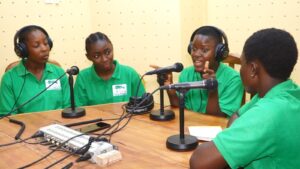
Home TV-Douala in the Littoral Region of Cameroon, and Mount Nlonako FM Radio are the main media used to reach out to communities in the Mount Nlonako Area with goliath frog conservation messages. One of the high points of the outreach and sensitization campaign is May 20, 2023, being Cameroon’s National Day Celebration and Endangered Species Day. The about 100 kids marched past in front of over 1000 community members including traditional authorities, policy makers and local administrators amongst others brandishing posters and drawings of the goliath frog and other endangered amphibians species they want protected. They also brandished unique conservation messages like: “Stop the hunting of the Goliath frog, it is an endangered species”, “amphibians are great contributions to our ecosystem, save their habitats” etc. and set up an amphibians conservation exhibition stand in Ebone. The young amphibians conservation ambassadors have a clear message for their parents and friends in the Mount Nlonako Area.
Elapenda Sidonie from Ntolo says “it is our responsibility to conserve the goliath frog for our children and children’s children to grow and also see. I call on the population to stop indiscriminate hunting of the frog and make its conservation their priority”. Bothcou Marie Therese, from Nkongnine recommends that “denizens of the Mount Nlonako Area shuns water pollution, deforestation, setting of traps and indiscriminate hunting to save the goliath frog at brink of extinction.”
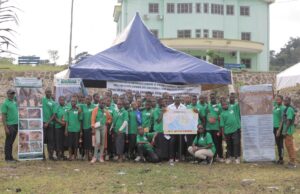
These messages are weaved into three songs, which are being played on community radio stations, and poems, drawings, articles and stories for continuous education and sensitization about the frog and other endangered amphibians in the Mount Nlonako Area.
Local Leaders Respond
Local leaders and community members have not remained indifferent to the conservation messages on goliath frog and other endangered species in the Mount Nlonako Area sent out by VoNat and about 100 kids and youths through the community-wide outreach and sensitization campaign. The Divisional Officer of Nlonako Subdivision, Mr Elenga Abina Alphonse, says “These endangered species and their habitats have to be conserved. I received in audience the Executive Director of VoNat and have pledged my support for this initiative”.
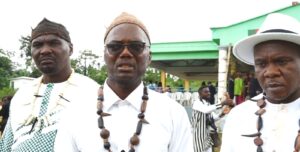
The traditional ruler of Mangamba, Chief Roland Essengue Mbonda, says “I agree with the children that the goliath frogs are other species in this area are our patrimony, inherited from our ancestors. It is our responsibility to conserve them for our children and the future generation. So, we will take necessary dispositions to ensure that they don’t become extinct”.
The Nlonako Sub divisional Delegate of the Cameroon Ministry of Forestry and Wildlife (MINFOF), Madam Mokete Stella recommends that “VoNat should support Government’s efforts by creating touristic sites for frog watching”. According to her, such action will contribute to conserving the frogs and their habitats will contributing to local development.
Hunters Demand Alternatives
Though some hunters are conscious that their wanton hunting activities are driving the goliath frogs gradually towards extinction, they say it remains a key source of protein and livelihoods for them and their families. According to one of the hunters Mr. Lakatouch, “the frog is our own meat. You cannot eat plantains without meat; it cannot go. We also sell some to pay rents and meet the needs of our family”. The hunter adds: “if I have another means of survival or a lucrative business, I will not be risking myself at night hunting the frogs. It will provide enough money that I can buy fish or chicken as meat for the house”.

Mr. Mbapeh Njoh Richard, is aware that hunting the goliath frogs and other endangered species is against the Cameroon Forestry Law but insists it is brisk business. “We sell the goliath frog for up to XAF 20000 (about $40) depending on the size. So stopping it is not easy,” he quips.
With more conservation consciousness generated in the Mount Nlonako area, there is an urgent need to provide alterative sustainability schemes to frog hunters and farmers to divert their attention from depleting these emblematic species and their habitats. There is also need for more hands-on conservation actions with the community kids and youths to sustain the new-found conservation zeal.
